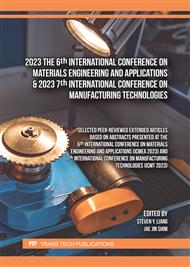[1]
Dahotre, N.B., Nayak, S. Nanocoatings for engine application. Surf. Coat. Technol. 194 (1), 58–67 (2005).
Google Scholar
[2]
Kano, M. Super low friction of DLC applied to engine cam follower lubricated with ester-containing oil. Tribol. Int. 39 (12), 1682–1685 (2006).
DOI: 10.1016/j.triboint.2006.02.068
Google Scholar
[3]
Carbone, G., Mangialardi, L., Analysis of the adhesive contact of confined layers by using a Green's function approach. J. Mech. Phys. Solids 56 (2), 684–706 (2008).
DOI: 10.1016/j.jmps.2007.05.009
Google Scholar
[4]
Menga, N., Afferrante, L., Carbone, G. Adhesive and adhesiveless contact mechanics of elastic layers on slightly wavy rigid substrates. Int. J. Solids Struct. 88, 101–109 (2016).
DOI: 10.1016/j.ijsolstr.2016.03.016
Google Scholar
[5]
Menga, N., Afferrante, L., Carbone, G. Effect of thickness and boundary conditions on the behavior of viscoelastic layers in sliding contact with wavy profiles. J. Mech. Phys. Solids 95, 517–529 (2016).
DOI: 10.1016/j.jmps.2016.06.009
Google Scholar
[6]
Menga, N., Afferrante, L., Demelio, G.P., Carbone, G. Rough contact of sliding viscoelastic layers: Numerical calculations and theoretical predictions. Tribol. Int. 122, 67–75 (2018).
DOI: 10.1016/j.triboint.2018.02.012
Google Scholar
[7]
Menga, N., Dini, D., Carbone, G. Tuning the periodic V-peeling behavior of elastic tapes applied to thin compliant substrates. Int. J. Mech. Sci. 170, 105331 (2020).
DOI: 10.1016/j.ijmecsci.2019.105331
Google Scholar
[8]
Menga, N., Bottiglione, F., & Carbone, G. Nonlinear viscoelastic isolation for seismic vibration mitigation. Mech. Syst. Signal. Process., 157, 107626 (2021).
DOI: 10.1016/j.ymssp.2021.107626
Google Scholar
[9]
Nowell, D., Hills, D.A., Sackfield, A. Contact of dissimilar elastic cylinders under normal and tangential loading. J. Mech. Phys. Solids 36 (1), 59–75 (1988).
DOI: 10.1016/0022-5096(88)90020-8
Google Scholar
[10]
Chen, W.W., Wang, Q.J. A numerical model for the point contact of dissimilar materials considering tangential tractions. Mech. Mater. 40 (11), 936–948 (2008).
DOI: 10.1016/j.mechmat.2008.06.002
Google Scholar
[11]
Nowell, D., Hills, D.A. Tractive rolling of tyred cylinders. Int. J. Mech. Sci. 30 (12), 945–957 (1988).
DOI: 10.1016/0020-7403(88)90076-8
Google Scholar
[12]
Jaffar, M.J. A numerical investigation of the sinusoidal model for elastic layers in line contact. Int. J. Mech. Sci. 39 (5), 497–506 (1997).
DOI: 10.1016/s0020-7403(96)00076-8
Google Scholar
[13]
Menga, N. Rough frictional contact of elastic thin layers: The effect of geometric coupling. Int. J. Solids Struct. 164, 212–220 (2019).
DOI: 10.1016/j.ijsolstr.2019.01.005
Google Scholar
[14]
Menga, N., Carbone, G., Dini, D. Exploring the effect of geometric coupling on friction and energy dissipation in rough contacts of elastic and viscoelastic coatings. Journal of the Mechanics and Physics of Solids, 148, 104273 (2021).
DOI: 10.1016/j.jmps.2020.104273
Google Scholar
[15]
Müser, M. H., et Al. (2017). Meeting the contact-mechanics challenge. Tribology Letters, 65(4), 1-18.
Google Scholar
[16]
Carbone, G., & Bottiglione, F. (2008). Asperity contact theories: Do they predict linearity between contact area and load?. Journal of the Mechanics and Physics of Solids, 56(8), 2555-2572.
DOI: 10.1016/j.jmps.2008.03.011
Google Scholar
[17]
Greenwood, J. A., & Williamson, J. P. (1966). Contact of nominally flat surfaces. Proceedings of the royal society of London. Series A. Mathematical and physical sciences, 295(1442), 300-319.
DOI: 10.1098/rspa.1966.0242
Google Scholar
[18]
Bush, A.W. , Gibson, R.D. , Thomas, T.R. , 1975. The elastic contact of a rough surface. Wear 35, 87–111
DOI: 10.1016/0043-1648(75)90145-3
Google Scholar
[19]
Campaná, C., & Müser, M. H. (2007). Contact mechanics of real vs. randomly rough surfaces: A Green's function molecular dynamics study. EPL (Europhysics Letters), 77(3), 38005.
DOI: 10.1209/0295-5075/77/38005
Google Scholar
[20]
Campañá, C., Müser, M. H., & Robbins, M. O. (2008). Elastic contact between self-affine surfaces: comparison of numerical stress and contact correlation functions with analytic predictions. Journal of Physics: Condensed Matter, 20(35), 354013.
DOI: 10.1088/0953-8984/20/35/354013
Google Scholar
[21]
Persson, B. N. (2006). Contact mechanics for randomly rough surfaces. Surface science reports, 61(4), 201-227.
DOI: 10.1016/j.surfrep.2006.04.001
Google Scholar
[22]
Carbone, G., Mandriota, C., & Menga, N. (2022). Theory of viscoelastic adhesion and friction. Extreme Mechanics Letters, 56, 101877.
DOI: 10.1016/j.eml.2022.101877
Google Scholar
[23]
Persson, B. N. (2001). Theory of rubber friction and contact mechanics. The Journal of Chemical Physics, 115(8), 3840-3861.
DOI: 10.1063/1.1388626
Google Scholar
[24]
Persson, B. N., Albohr, O., Tartaglino, U., Volokitin, A. I., & Tosatti, E. (2004). On the nature of surface roughness with application to contact mechanics, sealing, rubber friction and adhesion. Journal of physics: Condensed matter, 17(1), R1.
DOI: 10.1088/0953-8984/17/1/r01
Google Scholar



